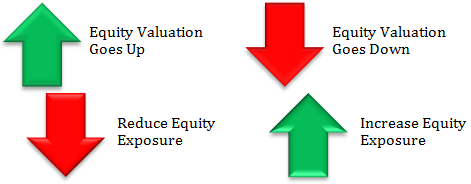
Table of Contents
HDFC Balanced Fund Vs HDFC Prudence Fund
HDFC Balanced Fund and HDFC Prudence Fund both belong to the same Fund house, HDFC Mutual Fund. Both the schemes belong to hybrid category equity oriented schemes. These schemes invest their corpus in both equity as well as debt instruments. However, since they are equity-based schemes under balanced category; they invest more in equity instruments as compared to fixed Income instruments. Though both the funds belong to the same fund house, however; they exhibit different characteristics with respect to AUM, their current NAV, returns, and many other related parameters. So, let us understand the differences between HDFC Balanced Fund and HDFC Prudence Fund through this article.
Overview of HDFC Balanced Fund (Merged with HDFC Hybrid Equity Fund)
HDFC Balanced Fund, which is now merged with HDFC Hybrid Equity Fund, is a part of HDFC Mutual Fund under Balanced Fund category. It is an open-ended balanced fund scheme that was launched on September 11, 2000. The objective of the scheme is to generate long-term Capital appreciation along with current income by Investing in a mix of equity and debt instruments. The scheme is suitable for investors who are looking out for long-term capital growth along with current income. HDFC Balanced Fund uses CRISIL Balanced Fund Index along with Nifty 50 Index to construct its Portfolio.
As on January 31, 2018, the top constituents forming part of the HDFC Balanced Fund’s portfolio include HDFC Bank Limited, Infosys Limited, ICICI Bank Limited, Axis Bank Limited, and Tata Steel Limited.
The scheme invests around 40% - 60% of its accumulated fund money in equity instruments while the rest in debt instruments.
About HDFC Prudence Fund (Merged with HDFC Balanced Advantage Fund)
HDFC Prudence Fund, now merged with HDFC Balanced Advantage Fund, is also a part of HDFC Mutual Fund and was launched on February 01, 1994. It is an open-ended scheme whose investment objective is to periodic returns along with capital appreciation by investing in a proper mix of equity and debt instruments. This scheme based on its in-line objective invests around 40-75% of its corpus in equity instruments and the remaining funds in Fixed Income instruments. HDFC Prudence Fund is suitable for investors looking out for periodic income combined with a capital appreciation and preventing capital erosion over long-term.
As on January 31, 2018, some of the top 10 constituents of HDFC Prudence Fund’s portfolio include State Bank of India, Larsen & Toubro Limited, NTPC Limited, and Vedanta Limited.
HDFC Balanced Fund Vs HDFC Prudence Fund
Though both the funds belong to the same fund house and same category yet; there exists a difference between them with respect to AUM, current NAV, Fincash Ratings and much more. These differences are divided into four sections, namely, Basics Section, Performance Section, Yearly Performance Section, and Other Details Section. So, let us understand the differences between both the funds based on these sections.
Basics Section
The various comparable parameters in case of basics section are Scheme Category, Fincash Ratings, Current NAV, AUM, expense ratio, and many more. To begin with the Scheme Category, it can be said that both the schemes belong to the same category that is, Hybrid Balanced – Equity.
In Fincash Ratings, we can say that HDFC Balanced Fund is rated as 5-Star, while HDFC Prudence Fund is rated as 3-Star.
The table given below summarizes the elements of this section.
Parameters Basics NAV Net Assets (Cr) Launch Date Rating Category Sub Cat. Category Rank Risk Expense Ratio Sharpe Ratio Information Ratio Alpha Ratio Benchmark Exit Load HDFC Hybrid Equity Fund
Growth
Fund Details ₹114.676 ↑ 0.30 (0.26 %) ₹23,229 on 31 Mar 25 6 Apr 05 ☆☆ Hybrid Hybrid Equity 57 Moderately High 1.7 0.07 0 0 Not Available 0-1 Years (1%),1 Years and above(NIL) HDFC Balanced Advantage Fund
Growth
Fund Details ₹501.785 ↑ 0.39 (0.08 %) ₹90,375 on 28 Feb 25 11 Sep 00 ☆☆☆☆ Hybrid Dynamic Allocation 23 Moderately High 1.43 -0.27 0 0 Not Available 0-1 Years (1%),1 Years and above(NIL)
Performance Section
This section compares the CAGR or Compounded Annual Growth Rate for both the schemes at various time periods. Some of the time periods for which the performance is compared are 1 Month Returns, 6 Month Returns, 1 Year Returns and Returns Since Inception. On a hindsight, we can say that there is not much difference on the returns generated by both the schemes. In certain time periods, the returns generated by HDFC Balanced Fund is higher while in other HDFC Prudence Fund leads the race. The table given below shows the CAGR performance of both the schemes.
Parameters Performance 1 Month 3 Month 6 Month 1 Year 3 Year 5 Year Since launch HDFC Hybrid Equity Fund
Growth
Fund Details 3.3% 3.4% 0.9% 9.6% 13% 20.7% 15.3% HDFC Balanced Advantage Fund
Growth
Fund Details 2.8% 3% 0% 9.6% 19.4% 25.8% 18.2%
Talk to our investment specialist
Yearly Performance
Yearly performance between both the schemes compares the absolute returns generated by each scheme for a particular year. In case of yearly performance, there is not much difference between the returns generated between both the schemes. The summary of yearly performance section is tabulated as follows.
Parameters Yearly Performance 2023 2022 2021 2020 2019 HDFC Hybrid Equity Fund
Growth
Fund Details 12.9% 17.7% 8.9% 25.7% 13.4% HDFC Balanced Advantage Fund
Growth
Fund Details 16.7% 31.3% 18.8% 26.4% 7.6%
Other Details Section
This is the last section of comparing funds. The comparable parameters that form part of Other Details Section include Minimum SIP and Lumpsum Investment. Being a part of the same fund house, the Minimum SIP and Lumpsum Investment for both HDFC Balanced Fund and HDFC Prudence Fund are the same. Here, the Minimum SIP investment is INR 500 while the lumpsum investment is INR 5,000.
Mr. Rakesh Vyas and Mr. Prashant Jain are the fund managers for HDFC Balanced Fund scheme.
Mr. Rakesh Vyas and Mr. Prashant Jain together are the fund managers of HDFC Prudence Fund.
The table given below summarizes the other details section.
Parameters Other Details Min SIP Investment Min Investment Fund Manager HDFC Hybrid Equity Fund
Growth
Fund Details ₹300 ₹5,000 Chirag Setalvad - 17.93 Yr. HDFC Balanced Advantage Fund
Growth
Fund Details ₹300 ₹5,000 Anil Bamboli - 2.59 Yr.
Growth of 10k Investments over the years
HDFC Hybrid Equity Fund
Growth
Fund Details Growth of 10,000 investment over the years.
Date Value 31 Mar 20 ₹10,000 31 Mar 21 ₹15,866 31 Mar 22 ₹18,728 31 Mar 23 ₹19,965 31 Mar 24 ₹24,529 31 Mar 25 ₹26,287 HDFC Balanced Advantage Fund
Growth
Fund Details Growth of 10,000 investment over the years.
Date Value 31 Mar 20 ₹10,000 31 Mar 21 ₹15,696 31 Mar 22 ₹18,998 31 Mar 23 ₹21,519 31 Mar 24 ₹30,051 31 Mar 25 ₹32,636
Detailed Assets & Holdings Comparison
HDFC Hybrid Equity Fund
Growth
Fund Details Asset Allocation
Asset Class Value Cash 1.2% Equity 67.74% Debt 31.06% Equity Sector Allocation
Sector Value Financial Services 23.85% Technology 8.64% Industrials 8.53% Consumer Defensive 6.52% Energy 5.64% Communication Services 4.39% Health Care 4.12% Consumer Cyclical 3.2% Utility 1.17% Real Estate 0.88% Basic Materials 0.59% Debt Sector Allocation
Sector Value Government 16.28% Corporate 14.14% Cash Equivalent 1.84% Credit Quality
Rating Value AA 8.21% AAA 91.79% Top Securities Holdings / Portfolio
Name Holding Value Quantity ICICI Bank Ltd (Financial Services)
Equity, Since 30 Nov 10 | ICICIBANK8% ₹1,758 Cr 14,600,000 HDFC Bank Ltd (Financial Services)
Equity, Since 31 Aug 13 | HDFCBANK7% ₹1,635 Cr 9,440,000 Bharti Airtel Ltd (Communication Services)
Equity, Since 31 May 12 | BHARTIARTL4% ₹942 Cr 6,000,000 Infosys Ltd (Technology)
Equity, Since 31 Jan 03 | INFY4% ₹903 Cr 5,351,604 Reliance Industries Ltd (Energy)
Equity, Since 31 Mar 18 | RELIANCE4% ₹882 Cr 7,350,000 State Bank of India (Financial Services)
Equity, Since 31 Oct 11 | SBIN3% ₹772 Cr 11,208,071 ITC Ltd (Consumer Defensive)
Equity, Since 31 May 15 | ITC3% ₹739 Cr 18,714,400 Larsen & Toubro Ltd (Industrials)
Equity, Since 30 Nov 11 | LT3% ₹708 Cr 2,237,093 7.34% Govt Stock 2064
Sovereign Bonds | -3% ₹615 Cr 60,000,000
↑ 10,000,000 7.09% Govt Stock 2054
Sovereign Bonds | -2% ₹547 Cr 55,000,000 HDFC Balanced Advantage Fund
Growth
Fund Details Asset Allocation
Asset Class Value Cash 8.45% Equity 60.71% Debt 30.84% Equity Sector Allocation
Sector Value Financial Services 21.86% Industrials 7.75% Energy 7.1% Technology 6.26% Consumer Cyclical 5.72% Utility 4.22% Health Care 4.2% Communication Services 2.69% Consumer Defensive 2.59% Basic Materials 2.04% Real Estate 1.57% Debt Sector Allocation
Sector Value Government 15.74% Corporate 14.63% Cash Equivalent 8.92% Credit Quality
Rating Value AA 0.91% AAA 99.09% Top Securities Holdings / Portfolio
Name Holding Value Quantity HDFC Bank Ltd (Financial Services)
Equity, Since 31 Mar 22 | HDFCBANK6% ₹5,160 Cr 29,787,551
↓ -4,127,200 ICICI Bank Ltd (Financial Services)
Equity, Since 31 Oct 09 | ICICIBANK4% ₹3,373 Cr 28,010,724
↓ -830,900 Infosys Ltd (Technology)
Equity, Since 31 Oct 09 | INFY3% ₹3,104 Cr 18,390,088
↑ 2,000,000 Reliance Industries Ltd (Energy)
Equity, Since 31 Dec 21 | RELIANCE3% ₹2,960 Cr 24,664,288
↓ -459,500 State Bank of India (Financial Services)
Equity, Since 31 May 07 | SBIN3% ₹2,718 Cr 39,455,000 7.18% Govt Stock 2033
Sovereign Bonds | -3% ₹2,342 Cr 228,533,300 NTPC Ltd (Utilities)
Equity, Since 31 Aug 16 | 5325552% ₹2,191 Cr 70,337,915 Larsen & Toubro Ltd (Industrials)
Equity, Since 30 Jun 12 | LT2% ₹2,103 Cr 6,645,683
↓ -168,950 Bharti Airtel Ltd (Communication Services)
Equity, Since 31 Aug 20 | BHARTIARTL2% ₹2,069 Cr 13,179,354
↑ 300,000 Coal India Ltd (Energy)
Equity, Since 31 Jan 18 | COALINDIA2% ₹2,063 Cr 55,854,731
Thus, from the above pointers, it can be said that both the schemes are different in case of various parameters though they belong to the same category and fund house. Therefore, individuals should always do a detailed study about a scheme before investing in it. They should check whether the fund’s objective is in-line with their objective. If required, people can consult a financial advisor for advice. This will ensure that their investment is safe and it paves way for wealth creation.
All efforts have been made to ensure the information provided here is accurate. However, no guarantees are made regarding correctness of data. Please verify with scheme information document before making any investment.






